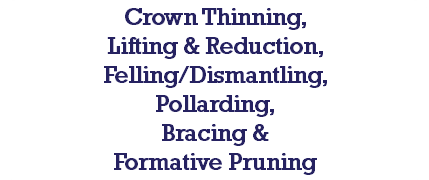

Crown Thinning – removal of a portion of smaller branches (e.g 10%, 15% thin – no more than 30% overall though) usually at the outer crown. It is usually confined to broad-leaved species that lose their leaves in Winter. Crown thinning does not alter the overall size or shape of the tree. Common reasons for crown-thinning are to allow more light through the canopy or to reduce wind resistance.
Crown Lifting – removal of the lowest branches and/or preparing of lower branches for future removal. Crown lifting is an effective method of increasing light to areas closer to the tree, or to enable access under the crown, but should be restricted to less than 15% of the live crown height crown lifting should be specified with reference to a fixed point e.g crown lift to give 5 m clearance above ground level.
Crown Reduction – reduction of height and/or spread of the crown of a tree. The final result should retain the main framework of the crown and leave a similar, only smaller, outline. Not all species are suitable for this treatment and crown reduction should not be confused with “topping” and other indiscriminate and harmful treatments.
Sectional Felling / Dismantling – dismantling a tree safely, sometimes using rigging techniques (ropes and pulleys) to lower manageable sections of tree to the ground.
Pollarding – initial removal of the top of a young tree at a prescribed height to encourage multistem branching from that point, traditionally for fodder, firewood or poles. Once started, it should be repeated on a cyclical basis always retaining the initial pollard point.
Bracing – the installation of cables, ropes and/or belts to reduce the probability of failure of one or more parts of the tree structure due to weakened elements under excessive movement.
Formative Pruning – minor pruning during the early years of a tree’s growth to establish the desired form and/or to correct defects or weaknesses that may affect structure in later life.

Hedge Trimming – keeping a hedge in a tidy form. We conduct trimming and shaping operations to all sorts of hedge (some of the main types of hedge we work are: Conifer, Holly, Hawthorn, Beech, Hornbeam, Laurel, Privet, Yew). There is a fine line between a hedge that looks okay and a hedge that looks amazing once it’s trimmed – see our testimonials to see what our hedge customers have said.
We view the tidy-up as just as important as the actual trimming!
Hedge Reduction – sometimes hedges are just too big for whatever reason, and require some more drastic action than just a trim. It can be hard to visualise what a hedge will look like once it is reduced, we will advise you regarding the options available to you and how these will affect your hedge and your garden.
Hedge Removal – when a trim and a reduction won’t do then complete hedge removal may be necessary whether this is due to disease or even if it is just time for a change. We can remove entire hedges including roots.
Hedge Planting – we advise on choosing hedging plants and when to plant them.
Hedge Laying – often needed when old hedges become thin and unruly. Laying involves partially cutting through the living stems to near ground level and bending them over as ‘pleachers’. This process encourages new shoots to sprout along the pleachers, thickening the hedge for the first few years after laying.
Created by aga-media.com